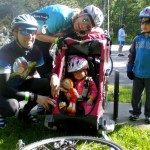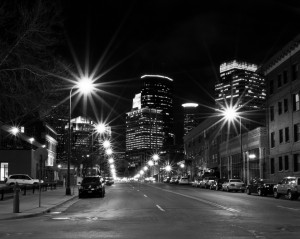
July 18, 2013
by julie
Comments Off on Ice Cream by Foot in St. Paul & Afield
This post cross-published from Streets.MN
On Monday, David discussed the challenge of walking anywhere when one lives in the neighborhood bordered by MN280 and I94. Because it’s July, and I operate on “any excuse necessary to discuss ice cream,” today we will discuss vendors of ice cream in St. Paul and in the Twin Cities where you can — and should — walk up to the window for ice cream. You may not walk to St. Paul, but you certainly can walk while in St. Paul. And if you’re walking, it’s ice cream time.
For the purposes of our exploration, I must define walk-up ice cream. By this I mean, one must never pass through a door to order and receive one’s dairy (or non-dairy) enlightenment. These have pedestrian, walk-up windows, and often little to no indoor seating. A patio is insufficient. They must be fixed in place, immobile — no ice cream trucks, food trucks, or vending carts, if you please. And they must be regularly available. Seasonal open is one thing, but having to stalk them through the metro is quite another. Ice cream must be a primary business line, as indicated by restaurant name or menu.
Thus, this is not a review of ice cream by gourmet merit. Our standards are clear: Walk up to the window, pay your money, get your choice. Employ teen ice cream slingers for the betterment of society. Walk off the calories you et.
Here are a few neighborhood ice cream purveyors where you can still walk up to a window and exchange your shekels for ice cream:
 Dairy Queen – 143 N. Snelling, St. Paul
Dairy Queen – 143 N. Snelling, St. Paul
Along the busy part of Snelling slightly north south of Midway and I94, this seasonal DQ is nestled not far from the site of controversial Buffalo Wild Wings developments, street calming, and bikeway plans. But it is also frequently bustling with activity on foot and bike, and in its limited parking area.
Conny’s Creamy Cone -Â 1197 Dale Street North, St. Paul
Not only is this neighborhood staple quite close to Como Park, it has a giant ice cream cone on its roof. You can also procure cheese curds there. It has some indoor seating, but it has the all-important (for our purposes) walk-up window.
 Dari-Ette -Â 1440 Minnehaha Ave E, Â St. Paul
Dari-Ette -Â 1440 Minnehaha Ave E, Â St. Paul
Dari-Ette is technically a drive-in, so some may question its presence on this list, given the criteria. To them, I say: fiddlesticks! There is also a very active walk-up window, with concrete picnic tables. These are regularly used by people of the neighborhood, walking on up for their ice cream cones and other dairy treats, in season.
 Dairy Queen -Â 565 Earl Street, St. Paul
Dairy Queen -Â 565 Earl Street, St. Paul
Another source for East Side ice cream needs, crossing the street to this location is best done at the nearby stop lights for best results (ie: avoiding near certain death as people race down Earl Street). This walk-up location is also special because its parking lot dwarfs the actual DQ location, which may simply be a statement about East Side property values more than it is a statement about vehicular culture.
 Cup & Cone -Â 2126 4th Street, White Bear Lake
Cup & Cone -Â 2126 4th Street, White Bear Lake
This classic walk-up ice cream shop is on a small island along the US61 strip in White Bear Lake. It is walking distance from the Marina and White Bear Beach, but be sure to cross at the stoplights and use the crosswalk button to maybe get enough time to shimmy across that roadway. The nearby strip mall adds quaint character. Okay, it doesn’t. Nonetheless, this is very accessible via a number of excellent bike routes and meets the standards of today’s exploration.
 Dairy Queen -Â 1720 Lexington Avenue Roseville
Dairy Queen -Â 1720 Lexington Avenue Roseville
Truly, I cannot leave this classic DQ out of this list, because even compared to how strip malls have erupted around the White Bear Cup & Cone, and the lot at the Earl Street DQ dwarfs the actual retail site, this DQ is special. It was the first Dairy Queen in Minnesota, with crazy original slanted windows and a light up ice cream cone atop its crazy roof. And around it has sprung strip malls, Taco Bells, margarita joints, Walgreens drive-throughs, and liquor stores. The building itself is on the Preservation Alliance of Minnesota’s 10 Most Endangered Historic Buildings list of 2010. It’s still completely legit as a walk-up vendor of ice cream.
No doubt, I am leaving some walk-up locations off this list, particularly DQs within Minneapolis — I think there are at least two on Lake Street, although the DQ closest to Minnehaha Park no longer has a walk-up window. I am leaving out some vendors who are debatably primarily in the ice cream business, such as Bread & Pickle at the Lake Harriet Pavilion, because while I’d suspect they do boom business in ice cream, they are called Bread & Pickle, you guys. Izzy’s Ice Cream and Grand Old Creamery of St. Paul have good pedestrian accessibility, but no walk-up windows. Adele’s Custard near Lake Minnetonka is bike-friendly and has a fantastic patio, but no walk-up windows.
So. Tell me what I missed in the comments below.






 Dairy Queen – 143 N. Snelling, St. Paul
Dairy Queen – 143 N. Snelling, St. Paul
 Dari-Ette -Â 1440 Minnehaha Ave E, Â St. Paul
Dari-Ette -Â 1440 Minnehaha Ave E, Â St. Paul Dairy Queen -Â 565 Earl Street, St. Paul
Dairy Queen -Â 565 Earl Street, St. Paul Cup & Cone -Â 2126 4th Street, White Bear Lake
Cup & Cone -Â 2126 4th Street, White Bear Lake Dairy Queen -Â 1720 Lexington Avenue Roseville
Dairy Queen -Â 1720 Lexington Avenue Roseville


